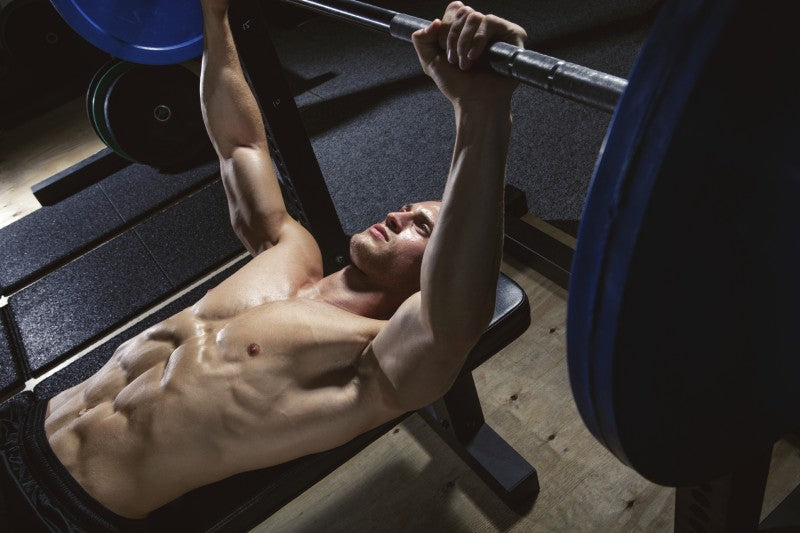
Improve Your Bench Press Power
If you've been to a gym, you've bench pressed. The bench press is undoubtedly the most popular resistance training exercise...by a mile.
Talk to anyone that lifts and they want to know one important thing...
The bench press is so popular that it gets its own division at powerlifting meets. The problem is, most lifters don't know how to do it correctly. It is not enough to just lie down on the bench and push the bar straight up.
While there are many ways to bench correctly, certain things remain constant when it comes to building a bigger bench press.

Top that off with the fact that a stronger back has a larger surface area, making it easier for you to push off the bench. Lifters who ignore the importance of back training create a hidden weakness; one most gym lifters have.
So how do you improve your back strength and size? Well first thing... You better have plenty of deadlifts and rows in your program. There is no better way to build a big ass slab of beef than to hammer out deads and rows.
 That leads me into the next area, the bench set up.
That leads me into the next area, the bench set up.
Now I am not even going to scratch the surface on the things that should go on before the rep even starts. We will save that for another article. But what I can tell you is that you are probably not using your legs correctly.
Yes, that's right. I said LEGS!
To handle more weight, and to perform the bench press as efficiently as possible, you have to learn to use good leg drive. Your legs should actually be sore, or at least a little tight, after a heavy bench day.
Now how do you make that happen? The easy quick tip is to drive your heels into the ground. It doesn't matter if you bench with your heels up or flat on the ground. Push them hard towards the ground if they are up, and drive them hard into the floor if they are down.
This will not only make you more stable, but provide more drive through the lift. You have to create speed!
There has been a lot of recent buzz about how slow and controlled movements can help to build strength. Well yeah, they can be helpful. But if you are looking to be both muscular and strong, you better move that damn weight fast!
Now how do you create speed? Well it's both very basic and very complex. The first step is to just go faster. Yeah I know seems dumb and way to simple, but that's really it.
Fast with the weight down, fast on the way up. Now don't read this and think I am talking about bouncing the bar off your chest. You still need to be in control, but just moving the weight more quickly.
Most lifters train for speed using a very low percentage of their one rep max. This work would often not be a part of their primary bench press training day,
How to best train for speed requires a complex answer, and is more difficult to explain. You will see a lot of lifters using accommodating resistance to increase speed in lifts. This should be left to advanced lifters who understand this type of training.

Talk to anyone that lifts and they want to know one important thing...
How much do ya bench?
This is a question seasoned gym rats get all the time. Hell, we gym rats even ask each other!The bench press is so popular that it gets its own division at powerlifting meets. The problem is, most lifters don't know how to do it correctly. It is not enough to just lie down on the bench and push the bar straight up.
While there are many ways to bench correctly, certain things remain constant when it comes to building a bigger bench press.

Not only does your chest move the bar from the bottom position, but your lats and entire upper back can be used to press the weight as well.
The Bench Press is Not Just a Chest Exercise!
Obviously the triceps and shoulders are big movers in the bench press, but that only tells part of the story. Have you ever seen a big bencher with a small back? I haven't! Not only does your chest move the bar from the bottom position, but your lats and entire upper back can be used to press the weight as well.Top that off with the fact that a stronger back has a larger surface area, making it easier for you to push off the bench. Lifters who ignore the importance of back training create a hidden weakness; one most gym lifters have.
So how do you improve your back strength and size? Well first thing... You better have plenty of deadlifts and rows in your program. There is no better way to build a big ass slab of beef than to hammer out deads and rows.
Use Your Legs - Yes, Your Legs!
 That leads me into the next area, the bench set up.
That leads me into the next area, the bench set up.Now I am not even going to scratch the surface on the things that should go on before the rep even starts. We will save that for another article. But what I can tell you is that you are probably not using your legs correctly.
Yes, that's right. I said LEGS!
To handle more weight, and to perform the bench press as efficiently as possible, you have to learn to use good leg drive. Your legs should actually be sore, or at least a little tight, after a heavy bench day.
Now how do you make that happen? The easy quick tip is to drive your heels into the ground. It doesn't matter if you bench with your heels up or flat on the ground. Push them hard towards the ground if they are up, and drive them hard into the floor if they are down.
This will not only make you more stable, but provide more drive through the lift. You have to create speed!
The Need for Speed
Speed is what can make the difference between an OK bench and a bad ass bench! Using the upper back and legs like I mentioned earlier, you need to generate speed throughout the entire lift.There has been a lot of recent buzz about how slow and controlled movements can help to build strength. Well yeah, they can be helpful. But if you are looking to be both muscular and strong, you better move that damn weight fast!
Now how do you create speed? Well it's both very basic and very complex. The first step is to just go faster. Yeah I know seems dumb and way to simple, but that's really it.
Fast with the weight down, fast on the way up. Now don't read this and think I am talking about bouncing the bar off your chest. You still need to be in control, but just moving the weight more quickly.
Most lifters train for speed using a very low percentage of their one rep max. This work would often not be a part of their primary bench press training day,
How to best train for speed requires a complex answer, and is more difficult to explain. You will see a lot of lifters using accommodating resistance to increase speed in lifts. This should be left to advanced lifters who understand this type of training.

Speed is what can make the difference between an OK bench and a bad ass bench!
Final Thoughts
So if you want to break away from the other gym rats, take my advice.- Build up that back by smashing some deadlifts and rows.
- Make sure you are getting the most from your legs during the lift.
- And make sure you are generating enough speed through the entire lift.
